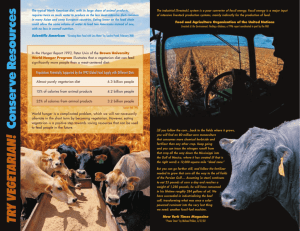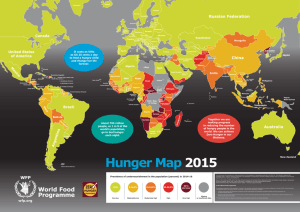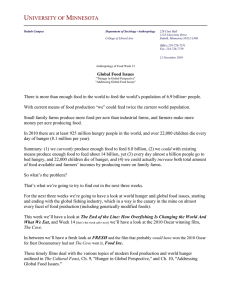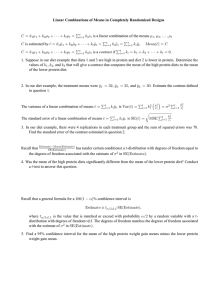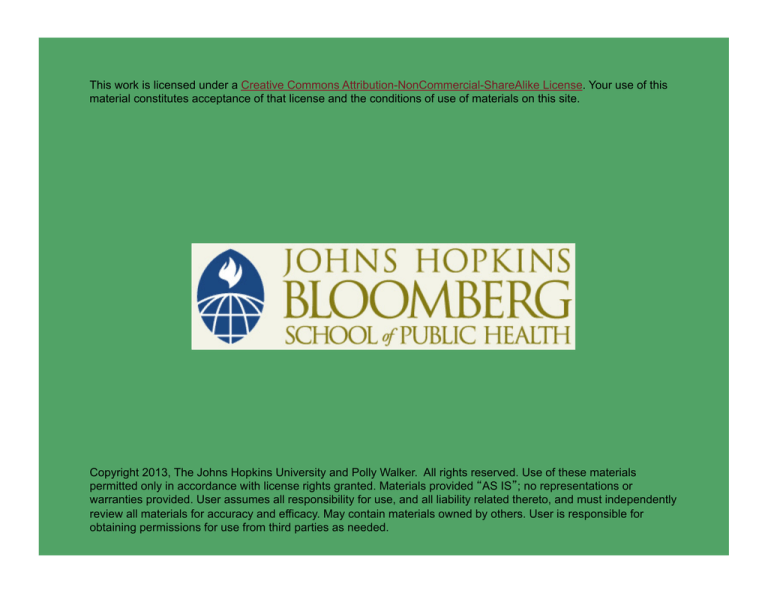
This work is licensed under a Creative Commons Attribution-NonCommercial-ShareAlike License. Your use of this
material constitutes acceptance of that license and the conditions of use of materials on this site.
Copyright 2013, The Johns Hopkins University and Polly Walker. All rights reserved. Use of these materials
permitted only in accordance with license rights granted. Materials provided “AS IS”; no representations or
warranties provided. User assumes all responsibility for use, and all liability related thereto, and must independently
review all materials for accuracy and efficacy. May contain materials owned by others. User is responsible for
obtaining permissions for use from third parties as needed.
A Brief Introduction to Food
Security and Food Systems
Polly Walker, MD, MPH
Johns Hopkins University
Section A
Food Security
What Is Food Security?
“Food security exists when all people, at all times, have
physical and economic access to sufficient, safe, and nutritious
food to meet their dietary needs and food preferences for an
active and healthy life.”
— Food and Agriculture Organization of the UN (FAO),1996
4
Food as a Human Right
n
Food is necessary for life and is a fundamental right
n
Universal Declaration of Human Rights (1948)*
-
Article 25: “Everyone has the right to a standard of living
adequate for the health and well-being of himself and of his
family including food, clothing, housing, and medical care and
necessary social services …”
*Retrieved from http://www.un.org/Overview/rights.html
5
Right to Food Further Defined
n
UN Economic and Social Council. (1999, May 12). General comment.
-
“The Committee affirms that … the right to adequate food is
indivisibly linked to the inherent dignity of the human person
and is indispensable for the fulfillment of other human rights
enshrined in the International Bill of Human Rights. It … is also
[and is] inseparable from social justice, requiring the adoption
of appropriate economic, environmental and social policies, at
both the national and international levels, oriented … to the
eradication of poverty and the fulfillment of all human rights
for all.”
-
Available at:
http://www.unhchr.ch/tbs/doc.nsf/(Symbol)/
3d02758c707031d58025677f003b73b9?Opendocument
6
Famine and Hunger
n
Hunger and famines have plagued mankind for millennia and have
been concerns of human societies for centuries
n
850 million worldwide are undernourished—a number that has
hardly changed since 1990 (UN, 2006)
n
20 million infants per year are born with low birth weights (FAO)
n
UN Millennium Development Goals
- Goal 1: “Eradicate extreme poverty and hunger”
- http://unstats.un.org/unsd/mdg/UNSD_MDG_Report_2007e.pdf
7
Concept of Food Security
n
Concept of food security first used in discussions about hunger in
the 1970s (World Food Conference, 1974)
Hunger was seen primarily as a “food problem”
n
Therefore, the goals to achieve food security were …
- Ensuring adequate production of food and national food selfsufficiency
-
Stabilizing the flow of food supplies
Sources: Overseas Development Institute; UN. (2006). Policy brief. Retrieved from
http://www.odi.org.uk/publications/briefing/1_97.html
8
Expansion of the Definition of Food Security
n
Access to available food by vulnerable people was added when the
FAO Committee on World Food Security formalized the formal
definition of food security in 1983
-
-
-
n
Ensuring adequacy of food supplies
Maximizing stability of supplies
Securing access to available supplies to all who need them
Activity level added to the goals of food security in a 1986 World
Bank position paper on poverty and hunger
-
“Food security must assure access by all people at all times to
enough food for an active and healthy life”
Source: FAO. Retrieved from http://www.fao.org/documents/show_cdr.asp?url_file=/DOCREP/
x0172e/x0172e01.htm
9
1996 Rome Declaration on World Food Security
n
Adopted by 176 countries and the European Community, the Rome
Declaration and its accompanying action plan set important goals
for world food security …
-
-
-
-
-
Within a context of the right to food
Improving access
Sustainable food production
Sustainable consumption
And underscoring that …
It is unacceptable that 800 million (in 1996) lack food for
basic nutritional needs
Poverty is a major cause of food insecurity
Source: World Food Summit, Rome, Italy. (1996, November 13–17). Retrieved from http://www.fao.org/documents/
show_cdr.asp?url_file=/DOCREP/003/W3613E/W3613E00.HTM
10
1996 Rome Declaration on World Food Security
n
Formal adoption of the right to adequate food—a milestone
-
n
“We reaffirm the right of everyone (present and future
generations) to have access to safe and nutritious food,
consistent with the right to adequate food and the fundamental
right of everyone to be free from hunger.”
While food supplies have increased, major problems persist that
prevent basic food needs from being met throughout the world,
including …
-
-
-
-
Lack of access
Inadequate household and national income
Instability of international trade
Manmade and natural disasters, including environmental
degradation
-
Conflict, terrorism, and corruption
11
Rome Declaration: Implementation Steps
n
Increased food production, including staple food, within the
framework of …
-
-
-
-
Sustainable management of natural resources
Sustainable agriculture, fisheries, forestry, and rural
development
Elimination of unsustainable patterns of consumption and
production, particularly in industrialized countries
Early stabilization of the world population
12
Goal 1: United Nations Millennium Development Goals
n
“Eradicate extreme poverty and hunger”
Targets for 1990 and 2015
1. Cut in half the proportion of people whose income is less
than $1 a day
2. Cut in half the proportion of people who suffer from
hunger
Source: UN. (2002). Millennium goals. Retrieved from http://www.un.org/millenniumgoals/
13
Progress on Millennium Development Goal (MDG) #1
n
Progress 1990–2004
-
-
Extreme poverty
The proportion of people living in extreme poverty fell
from nearly a third to less than one fifth
If the trend continues, the MDG poverty reduction target
will be met for the world and in most regions, except
western Asia, sub-Saharan Africa, and the European
transition countries
Children under 5, underweight
Globally, the proportion of children under 5 years old who
are underweight decreased by one-fifth
If trends continue, the target of halving the proportion of
underweight children will be missed by 30 million children,
mostly due to slow progress in southern Asia and subSaharan Africa
14
Food Security and Methods of Production
n
The International Food Policy Research Institute (IFPRI) 2001
definition of food security includes methods of production
-
A food-secure world is one “… where every person has access to
sufficient food to sustain a healthy and productive life, where
malnutrition is absent, and where food originates from
efficient, effective, and low-cost food systems that are
compatible with sustainable use of natural resources”
Source: IFPRI. (2001, September 4–6). Sustainable food security for all by 2020. Bonn.
Retrieved from http://www.ifpri.org/2020conference/
15
Why Do Food Production Methods Matter?
n
Environmental effects
-
-
-
-
n
Humans have already altered between one-third and one-half of
Earth’s non-ice-covered land, much of it for agriculture
200 years ago, average top soil depth was 21 inches on cropland
—today it’s 6 inches (UNESCO)
Almost 60 percent of the world’s freshwater withdrawals go
toward irrigation of crops (UNESCO)
Many major fisheries are fully exploited, in decline, or
collapsing; and current harvest is 25 percent greater than
sustainable yield
Economic effects
- Production methods have economic impacts on small-scale
farmers and retailers; rural communities
16
World Food Production
n
Total world grain production continues to grow and is adequate to
feed the world’s population if distributed equitably
n
Worldwatch Institute calculation based on world food production in
2004 of 2,049 billion tons
- Providing 322 kg of grain per person per year, or about 2,700
calories per person per day worldwide
-
-
n
This exceeds the 2,350 calorie minimum per day set by FAO
Adequate food is available to feed all the world’s people
In addition to inequitable distribution, there are now new threats to
the food supply
-
-
Using prime agricultural land to grow crops for biofuel
Climate change
Sources: Worldwatch Institute. (2005). Vital signs, 22–23; Children First. Retrieved from http://
www.childrenfirst.org.za/shownews?mode=content&id=17376&refto=2635
17
Hunger in a World of Plenty
n
Current world population is 6.7 billion and growing
-
-
n
One-fifth of the world’s people (or 1 billion people) are
undernourished or underweight
More than 5 million children die of hunger each year (one child
every 5 seconds)
Meanwhile …
- One-fifth of the world’s people (1 billion people) suffer from
diseases of over-nutrition, such as obesity, diabetes, and heart
disease
Such over-nutrition occurs mostly in more developed
countries and, increasingly now, among the urban elite in
developing countries
18
FAO World Hunger Map
Map source: FAO. Retrieved from http://www.fao.org/es/ess/faostat/foodsecurity/FSMap/map14.htm
19
Since Food Is Available, What Is the Problem?
n
Grain consumption per capita per year varies greatly across the
world
U.S.A.
~800 kg
Italy
~400 kg
Taiwan
~300 kg
China
~250 kg
India
~200 kg
20
Plant-Based Diets vs. Diets with Animal Protein
§ Height of red plane = actual world population to 2004, then estimated to 2050
§ Height of each hamburger = number of people that could be fed on a diet with 30
percent of calories from animal protein
§ Height of each globe = number of people that could be fed on a plant-based diet in
1990 and 2020
21
Plant-Based Diets vs. Diets with Animal Protein: 1990
A grain-based diet could feed …
6.2 billion
people
22
Plant-Based Diets vs. Diets with Animal Protein: 1990
A grain-based diet could feed …
An “American-style
diet,” high in protein,
could feed …
6.2 billion
people
2.5 billion
people
23
Plant-Based Diets vs. Diets with Animal Protein: 2025
9.5–10 billion people
A grain-based diet could feed …
An “American-style
diet,” high in protein,
could feed …
6.2 billion
people
2.5 billion
people
24
Plant-Based Diets vs. Diets with Animal Protein: 2025
9.5–10 billion people
A grain-based diet could feed …
6.2 billion
people
An “American-style
diet,” high in protein,
could feed …
2.5 billion
people
3.5–4 billion
people
1990
2025
Actual population
5.2 billion
7.9 billion (est.)
Grain-based diet could feed
6.2 billion
9.5–10 billion
American-style diet could feed
2.5 billion
3.4–4 billion
25
World Food Security and Diet
A population that relies on equitably distributed diet, principally
obtained from grains, represents our best chance for meeting the
world’s growing demand for food.
26
To Recap, Food Security Exists When …
n
… all people at all times (equity now and in the future)
n
have physical access (food is available to buy or produce)
n
and economic access (food is affordable)
n
to sufficient safe and nutritious food (quantity and quality are
adequate)
n
to meet their dietary needs (adequate for health)
n
and food preferences (food that is personally acceptable and
culturally appropriate)
n
for an active and healthy life (meets health and activity needs)
n
… and that food is produced in ways that are environmentally
sustainable (i.e., do not deplete or pollute resources such as soil,
water, and seed stocks) and socially just (fair to those who produce
the food)
n
and socially just (fair to those who produce the food)
27
How Does This Get Accomplished?
n
Goals of the 2008 UN food meeting: to address the crisis of
increasing food prices due to competition for grain (for biofuels,
meat production, and human consumption) plus impact of climate
change
-
-
-
-
Increase food production
Increase agricultural research
Institute policies to decrease food prices
Lower trade barriers
28
National, Regional, and Local Food Security
n
National food security
-
Re-establish national food self sufficiency—captured in the
concept of food sovereignty, the right of peoples and sovereign
states to democratically determine their own agricultural and
food policies
n
Local and regional food security
n
Household food security
29
Conclusion of Introduction
Photo source: USDA.
30

